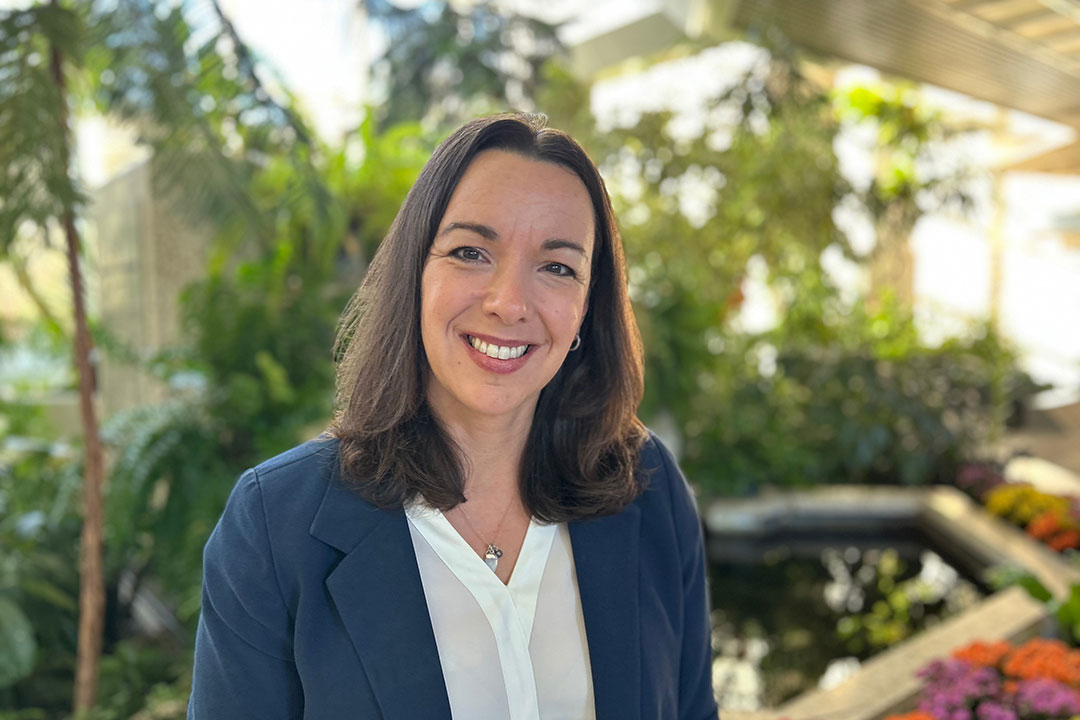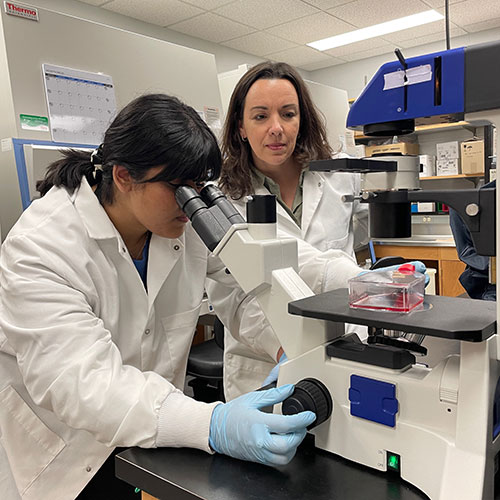
Celebrating outstanding teaching: Q & A with Dr. Natacha Hogan
For Dr. Natacha Hogan (PhD), some of the most gratifying moments of teaching are when she can get her students excited about science and they are able to connect what they learn to real-world challenges and their solutions.
By AgBio CommunicationsProfessor Hogan is the 2024 recipient of the University of Saskatchewan (USask) Provost’s College Award for Outstanding Teaching for the College of Agriculture and Bioresources (AgBio).
She also was the recipient of the North American Colleges and Teachers of Agriculture Teaching Award of Merit, recognizing her as the College of Agriculture and Bioresources’ top educator in 2023.
As an educator, Hogan draws upon real-world examples and integrates cutting-edge research into her curriculum, ensuring that her students are active participants in their learning.
To celebrate her teaching achievements, we asked Hogan to discuss her research and teaching experiences.
What does your research focus on?
In a broad context, my research involves identifying and understanding the impact of anthropogenic (man-made) and natural contaminants on animal health. One main area of study deals with contaminants in aquatic systems and understanding their potential risk to animals who live in these systems. The overall goal of this research is to help identify acceptable contaminant thresholds (or levels) that do not pose an appreciable risk to environmental, animal and human health. My research has examined many types of chemicals, including pesticides, pharmaceuticals, and disinfectant compounds as well as complex environmental mixtures, such as wastewater effluent, contaminated groundwater, and oil sands-impacted water. I am also concerned with exposure and effects of ingested contaminants on gut health—this includes mycotoxins and other naturally occurring toxins that can sometimes be found in animal feed.
I am particularly fascinated in the “how”—in other words, what are the specific mechanisms by which chemicals interact with and alter cells and tissues to cause disease and dysfunction in animals. Answering this question often involves experimental approaches that span many levels of biological organization from molecular biology to the whole animal. Exposure to contaminants often results in relatively rapid changes in levels or activity of small molecules, such as RNA, protein, or important microbes on the gills of fish or in the intestine. These small entities contribute to the overall function of a healthy animal, and we can measure their changes as an early indicator of contaminant exposure or predictor of adverse effects on animal health.
How did you develop an interest in this topic?
I have always loved science, animals, and environmental health. I grew up in rural Prince Edward Island, spent a lot of time outdoors and loved being near the ocean. My plan was to be an equine or wildlife veterinarian and I took every opportunity I could to volunteer and gain animal experience. But during my biology degree at the University of Prince Edward Island, I was fortunate to have some of the most amazing professors who were passionate about their subjects. They provided a truly integrative and holistic learning environment and helped students appreciate the connections between environmental health and animal systems. It was here that I had the chance to engage in an independent research project related to agricultural land-use and its influence on amphibian populations and I was hooked!
Through graduate school, I became fascinated with hormones—specifically, how the endocrine system regulates animal development and how environmental stressors, including contaminants, can mess up the hormone signals required for normal development during exquisitely sensitive periods in an animals’ life. After graduate studies, I was able to apply my expertise in animal physiology and molecular biology to the field of ecotoxicology, looking at the impacts of industrial activities and contaminants on fish health. This work brought me to the University of Saskatchewan, where I am part of both the College of AgBio and the Toxicology Centre—two amazing units that conduct impactful research and value experiential learning. And now I get to work with colleagues and students on research that is truly interdisciplinary, encompassing animal health, toxicology, environmental stress, and biotechnology. In the classroom, whether I am teaching a toxicology or animal bioscience class, I also try to encourage students to connect ideas across these disciplines.
What research project are you working on?
One current research effort aims to determine the potential biological effects of antimicrobial chemicals on fish health. Antimicrobial chemicals are produced and widely used by society for disinfection and preventing growth of micro-organisms. In addition, the use of products containing these chemicals has increased substantially inresponse to the COVID-19 pandemic. Antimicrobial chemicals are continuously released through wastewater effluents into aquatic systems where they may pose a risk to the health of aquatic organisms, including fish. Although they may not be acutely toxic or directly kill fish, the long-term, low-level exposure to these chemicals have potential to alter microbial communities that provide important barrier function on the gill or in the gut of fish. At an ecosystem level, these chemicals could very well alter communities of micro-organisms that form the base of the food web, which could over time affect fish populations. We are conducting controlled exposure studies with different fish species in the lab to understand species-specific toxicity and potential mechanisms of action. We are also part of a whole ecosystem study being conducted at the International Institute for Sustainable Development (IISD) Experimental Lakes Area in Ontario that will generate ecologically relevant data to support development of water quality guidelines for such chemicals and to protect aquatic ecosystems.

How does your research benefit the agriculture sector?
Different species and strains of animals respond differently to contaminant exposure. This means that toxicity threshold values developed for one compound in one species, strain, and even life-stage of an animal may not be generally applicable to another. My studies often explore how these biological factors, developmental processes and exposure scenarios contribute to differences in sensitivity. For animal producers, identifying situations where their animals are most susceptible to contaminant exposure through their feed or water means they can take steps to avoid exposure or apply strategies to mitigate toxicity.
What inspires/motivates you in your teaching and research?
Engaging with students is a major motivation for me, whether it is teaching in the classroom, working beside them in the lab or field, or discussing their poster at a scientific meeting. I find their level of enthusiasm and curiosity just so inspiring, and it often stimulates new ideas for the research. In terms of teaching, the most gratifying moments for me are when I can get students excited about the science and then they connect what they learn to real-world situations— the “eureka” moments!
Tell us about a mentor or supporter who made an impact on you.
I have been fortunate to have wonderful mentors at many stages of my career to support me as a learner, teacher, and scientist. Every one of my mentors has greatly impacted my goals and values both academically and scientifically, as well as ethically and personally. They have listened, led by example, provided valuable expertise, or challenged me—depending on what I needed at the time. I am so very appreciative and eternally grateful to each one of them and they have helped me develop my own values and approaches to mentoring. Parenting has also had a big influence on my mentoring style and just like with parenting, you don’t always get things right! But for me, mentoring is very similar. I ultimately want to help students to develop their own interests and skill sets, find their own strengths, and then see them follow their own paths.
What is your favourite thing about teaching?
The best thing about teaching is the absolute joy and satisfaction of seeing students connect with topics, become motivated to solve problems, and enjoy learning. I consider it such a privilege to be part of the whole process.
What advice would you give to students?
Be open to different perspectives, take advantage of opportunities, and do not close any doors! What we “know” is constantly changing and advancing, especially in disciplines that encompass agriculture and animal production, environmental health, and biotechnology. Dealing with big problems related to pollution, climate change, water and food security will only be possible by bringing together different approaches and applying what we “know” in new and novel ways.
Together, we will undertake the research the world needs. We invite you to join by supporting critical research at USask.

